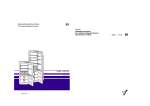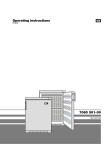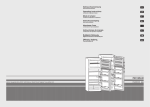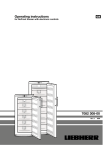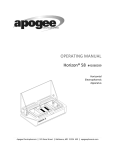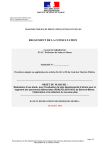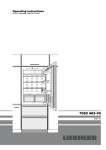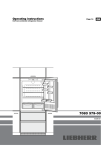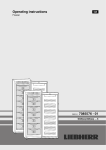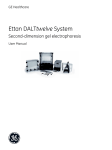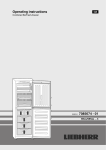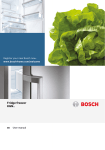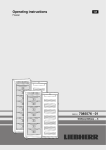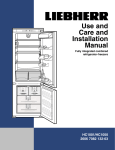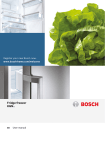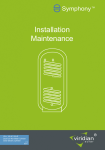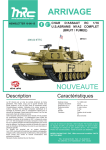Download KIKNV 3046 user manual
Transcript
Installation and operating instructions
for NoFrost combined refrigerator-freezers for integrated use
7082 046-00
KIKN 30..
1603
1
The appliance at a glance
Operating and control elements, fig. A1
Child-proof lock 6
Freezer
Prevents the appliance from being switched off
accidentally.
1 Temperature display and setting display
2 Temperature buttons: top button = higher,
bottom button = lower, recommended setting: -18°C
3 Main on/off switch
4 SuperFrost button with LED indicator showing
active function
5 Audible warning on/off button
Refrigerator
6 Child-proof lock (refrigerator and freezer display)
7 Temperature display and setting display
8 Temperature buttons: top button = higher,
bottom button = lower, recommended setting: 5°C
9 Refrigerator off button (freezer remains on)
bl SuperCooling button with LED indicator
W Hold down the audible warning on/off button and
then press the SuperFrost button and keep both
buttons pressed for about 3 seconds. A short
double beep will sound and the display 6 will light
up; the child-proof lock is now active.
- To switch off: press this key combination again; the
display will go off.
SuperCooling
For fast cooling of food in refrigerator:
W Press the SuperCooling button bl briefly so that
the LED comes on: the function is now switched on.
- Switches off automatically after approx. 6 hours.
showing active function
bm Fan with rocker switch*
Cooling with fan*
Description of appliance and equipment, fig. A
Refrigerator, approx. 5°C
Operating and control elements
Butter and cheese compartment
Interior light
For generating even temperatures on all of the
shelves. Recommended in the following situations:
- when the room temperature is high (approx. 30°C
or higher) or
- if the air humidity is high, e.g. during the summer.
W Press fan switch bm.
SuperFrost
Egg tray*
For fast freezing of fresh food:
W Press the SuperFrost button 4 briefly so that the
LED comes on.
W The freezer will take approx. 6 - 24 hours to reach
its lowest temperature.
W Place the fresh food in the top drawers.
Adjustable-height jar rack*
Fan with rocker switch*
Sectioned* shelf
- The SuperFrost function is switched off as required. The freezer will switch back automatically
to normal operation.
Adjustable* storage shelves
Space-saving bottle shelf*
Defrost drain
Vegetable, salad and fruit bins
Coldest area of the refrigerator compartment, suitable for cold-sensitive and highly perishable foods
Type/Data plate
Adjustable bottle holder*
Door rack for large bottles
Freezer, approx. -18°C
Freezer tray*, cold-storage accumulator*
Drawers with information system*
/FrostControl display
This means that the freezing temperature has risen
too high during the last few hours or days due to a
power failure. Check the quality of the food.
Type/Data plate, fig. A2
1
2
3
4
Type designation
Service number
Appliance number
Freezing capacity in 24 hours
Ice-cube tray*
12
* Depending on model and options
Congratulations on your purchase. In choosing this appliance you have opted for all the benefits of
state-of-the-art refrigeration technology, guaranteeing you top quality, a long life span and excellent
reliability.
The features on your appliance have been designed to ensure maximum convenience - day in, day
out.
This appliance has been manufactured with recyclable materials using an environmentally friendly
process, so together you and we are making an active contribution to the preservation of our
environment.
To get to know all the benefits of your new appliance, please read the information contained in these
operating instructions carefully.
We wish you much pleasure with your new appliance.
Contents
Operating instructions
Page
The appliance at a glance ................................. 12
Contents ............................................................ 13
Notes on energy saving ..................................... 13
Safety instructions and warnings ....................... 14
Disposal notes ................................................... 14
Installation and ventilation information .............. 14
Connecting to the mains .................................... 14
Operation and control elements ........................ 15
Safety regulations .............................................. 15
Switching the appliance on and off ................... 15
Setting the temperature ..................................... 15
Child-proof lock .................................................. 15
Temperature display .......................................... 16
Audible warning signal ...................................... 16
Power failure/FrostControl display .................... 16
SuperCooling ..................................................... 16
Cooling with fan ................................................. 16
Refrigerator compartment ................................. 17
Arranging food in the refrigerator ...................... 17
Changing shelf arrangement ............................. 17
Interior light ........................................................ 17
Freezer compartment ........................................ 18
SuperFrost ......................................................... 18
Notes on freezing and storage .......................... 18
Information system ............................................ 19
Freezer tray ....................................................... 19
Cold-storage accumulators ............................... 19
Making ice-cubes ............................................... 19
Defrosting, cleaning ........................................... 20
Troubleshooting ................................................. 20
Customer service and type plate ....................... 20
Before reading, please fold out
and refer to the illustrated front
page.
Keep these operating instructions in a safe place and pass
them on to the next owner,
where applicable.
The operating instructions apply to several models.
Differences may therefore occur.
Notes on energy saving
W Ensure that there is adequate space around the appliance
for ventilation and air extraction.
W Avoid keeping the door open for too long.
W Store food logically. Do not exceed the storage period
specified.
W Keep all food properly packed and covered so as to avoid its
frosting up on the outside.
W Always allow hot food to cool to room temperature before
placing in the appliance.
W Defrost frozen food in the refrigerator.
W Keep the appliance door shut in the event of a breakdown.
This will delay the cold loss and will help to maintain the
quality of the frozen food for longer.
Installation instructions
Changing over door hinges ............................... 21
Installation information ...................................... 21
Installation and attachment ............................... 21
13
Safety instructions and warnings
Disposal notes
W
W
The packaging is designed to protect the appliance
and individual components during transport and is
made of recyclable materials.
Corrugated board/board
Moulded polystyrene (foamed, CFC-free polystyrene)
Polythene bags and sheets
Polypropylene straps
Keep packaging materials away from children polythene sheets and bags can suffocate!
Please return the packaging material to your nearest official
collection point so that the various materials can be reused
or recycled as far as possible.
Your old appliance:
This contains some reusable materials and should not simply be
disposed of with household or bulk refuse.
W Disable discarded appliances immediately by removing the
plug and cutting through the connection cable.
Remove the spring-action or bolt catch from the appliance or render it unusable so that children cannot
become trapped inside and suffocate.
W Ensure that the refrigerant circuit is not damaged before the
appliance that is no longer needed is taken away for
disposal. In this way the refrigerant or oil will not escape
into the environment.
- Exact details of the refrigerant used can be found on the
type plate. The heat insulator is PU with Pentane.
- Information on collection dates or collection points can be
obtained from the waste disposal authorities or local
council.
W Do not let children play with the appliance, e.g. do not allow them to sit in the drawers or swing on the door.
W Do not eat ice-cream, particularly ice lollies or ice-cubes,
immediately after taking them from the freezer compartment as there is a risk of "burning" because of the very
cold temperatures.
W Do not consume food which has been stored for too long,
as it could cause food poisoning.
Installation and ventilation information
W When setting up or fitting ensure that the refrigerant circuit
pipes are not damaged.
W Do not block the ventilation areas. Always
ensure that the appliance is properly ventilated.
W Standard EN 378 specifies that the room in which
you install your appliance must have a volume of
1 m3 per 8 g of R 134a refrigerant used in the
appliance,
W
W
-
Connecting to the mains
Technical safety
W To prevent injury or damage to the unit, the appliance should only be transported wrapped and set
up by two people.
W The refrigerant R 134a
W Do not damage the refrigerant circuit pipes. Splashes of
refrigerant can harm your eyes or ignite.
W If refrigerant escapes, remove all naked flames or sources
of ignition in the vicinity of the leak, disconnect the appliance from the mains and ventilate the area well.
W In the event that the appliance is damaged, contact the
supplier immediately before connecting to the mains.
W To guarantee safe operation, ensure that the appliance is
set up and connected as described in these operating
instructions.
W Disconnect the appliance from the mains if any fault occurs.
Pull out the plug (not by pulling on the mains cable) or
switch off or remove the fuse.
W Any repairs and work on the appliance should only be
carried out by the customer service department, as
unauthorised work could prove highly dangerous for the
user. The same applies to changing the mains power cable.
Safety during use
W
W
W
W
W
W Do not store explosives or sprays using combustible
propellants such as butane, propane, pentane, etc. in
the appliance. Electrical components might cause
leaking gas to ignite. You can identify such sprays by the
printed contents or a flame symbol.
Only store high-percentage alcohol in tightly sealed, upright
containers.
Do not allow naked flames or ignition sources to enter the
appliance.
Do not use electrical appliances inside the appliance (e.g.
steam cleaners, heaters).
The appliance is not intended for use by young children or
infirm persons without supervision.
Do not stand on the plinth, drawers or doors or use them to
support anything else.
14
The quantity of refrigerant used in your appliance is
indicated on the type plate on the inside of the appliance.
Refer to the appendix in the installation instructions.
Following installation: Remove all transportation safety
components.
Remove sticky tape or spacers* from shelves and insert
shelves in the required position.
Remove all protective film: from the decorative trims and
drawer fronts.
W
W
W
Power supply (AC) and voltage
at the operating point must comply with the details on
the type plate. The type plate is located on the inside
left of the appliance, fig. A2.
W The appliance must be connected with a properly
installed fused socket.
The socket must have a 10 A fuse or higher. It must be
away from the back of the appliance and easily accessible.
Do not
connect to stand-alone inverters,
operate with so-called energy-saving plugs - this can
damage the electronic system,
connect to the supply with other equipment using an
extension cable - risk of overheating.
When removing the mains cable from the back of the
appliance, remove the cable holder to prevent vibration
noise.
The wires in the mains lead are coloured in accordance with
the following code: green/yellow = earth, White = neutral,
Black= live.
Warning! This appliance must be earthed.
Non-rewireable plugs BS 1363
If this machine or appliance is fitted with a non-rewireable
plug, the following information applies: If the socket outlets
are not suitable for the plug supplied with this product, it must
be cut off and an appropriate plug fitted. The plug cut from
the flexible cord should be disposed of and on no account be
inserted into a 13 A socket elsewhere in the house (electric
shock hazard).
The fuse cover must be re-fitted when changing the fuse, and
if the fuse cover is lost the plug must not be used until a
suitable replacement is obtained. The colour of the correct
replacement cover is that of the coloured insert in the base of
the plug, or the colour that is embossed in words on the base
of the plug (as applicable to the design of the plug fitted). The
correct rating of the replacement fuses that are ASTA approved to BS 1362 should be fitted. Replacement fuse covers
may be purchased from your local electrical suppliers, electricity showroom or approved service agent.
Operation and control elements
Safety regulations
Setting the temperature
W The appliance is designed to cool, freeze and store food
and to make ice. It is designed as a household appliance.
If used commercially, the relevant regulations on commercial use must be observed.
W The appliance is set to operate within specific ambient
temperature limits according to its climate rating. These
temperature limits should not be exceeded. The correct
climate rating for your appliance is indicated on the type
plate. This is explained as follows:
Climate rating
Set for ambient
temperatures of
Fig. A1: The appliance is pre-set for normal operation. We
recommend temperatures of +5°C in the refrigerator and
-18°C in the freezer.
To reduce the temperature:
Press the bottom button;
8 on left for refrigerator and 2 on right for freezer.
To increase the temperature:
Press the top button.
SN
N
ST
T
+10°C to +32°C
+16°C to +32°C
+18°C to +38°C
+18°C to +43°C
- The refrigerant circuit has been tested for leaks.
- When installed, this appliance corresponds to the relevant
safety provisions and EC directives 73/23/EEC and
89/336/EEC.
You are advised to clean the appliance before switching it on
for the first time (see "Cleaning").
Switch on the appliance several hours before loading it with
frozen food for the first time. Do not load with frozen food until
the temperature shows approx. -18°C.
Switching the appliance on and off
- Fig. A1: Pressing the main on/off switch 3 always
switches the entire appliance, both the refrigerator and
the freezer compartment, on or off.
W Switching on: Press the on/off buttons 3 or 9 so that the
temperature displays 1 and 7 light up or flash.
- The freezer compartment is switched on when the temperature display 1 is on.
- The alarm will sound when the appliance is switched on for
the first time and when the appliance is "warm".
W Press the alarm off button 5 to switch it off. See the
"Audible warning signal" for more information.
- While you are entering the temperature, the set temperature will flash on the display.
- When you press the temperature setting buttons for the
first time, the most recent setting (known as the "reference
setting") is displayed.
- You can change the settings in increments of 1°C by
briefly pressing the buttons again. If the buttons are held
down the temperature setting will change faster.
- Approximately 5 seconds after the button has been released, the display will automatically show the actual
freezing or cooling temperature (known as the "actual
setting").
- You can change the temperatures
in the refrigerator: between 11°C and 2°C and
in the freezer:
between -16°C and -26°C.
Whether you can obtain the lowest temperature depends
on where the appliance is positioned (if it is located in an
area with a high ambient temperature it will not reach the
lowest temperature).
Child-proof lock
W
W
Fig. A1: The child-proof lock is designed to protect the
appliance from being switched off accidentally.
Switching on the child-proof lock: Hold down the audible warning on/off button 5 and then press the SuperFrost button 4, and keep both buttons pressed simultaneously for approx. 3 seconds.
A double beep confirms your entry.
The child-proof lock display 6 will come on.
Switching off: Press this key combination again; the display 6 will now go out.
- The refrigerator compartment is switched on when the
temperature display 7 is on and the interior light is operational.
W Switching off: Switch off the entire appliance with the main
on/off switch 3 so that the temperature displays go out.
Note:
W If you only want to switch off the refrigerator compartment (keeping the freezer compartment switched on; useful
when you go on holiday, for example), press the on/off
switch 9. The refrigerator temperature display 7 and the
interior light will go out. The freezer temperature display 1
must remain on.
15
Operation and control elements
Temperature display
Fig. A1: In normal operation, the following
settings will be displayed:
- the average refrigerator temperature in display 7 and
- the warmest frozen food temperature in display 1.
When starting up for the first time or when the appliance is warm,
- dashes will appear until the temperature reaches a level that
can be displayed (19°C to 0°C in the refrigerator and below
0°C in the freezer).
- It will take between 3 and 8 hours for the required temperature (e.g. 5 or -18°C) to be reached and displayed permanently in the display, depending on the ambient conditions
and the temperature setting.
The display will flash:
- if you change the temperature or
- if the temperature rises by several degrees, indicating cold
loss, e.g. if you place fresh, "warm" food in the freezer or if
you remove or re-pack frozen food the temperature may rise
for a short time due to warm air flowing into the freezer.
Once you have finished loading or re-packing, the electronics will automatically re-set the temperature to the most
recent setting. Short-term rises in temperature will not affect
the frozen food.
W If "F0" to "F5" appears in the display, the appliance has a
fault. Consult the customer service department indicating
the fault number displayed as this will tell the technician
what kind of irregularity has occurred.
Power failure/FrostControl display
If
appears in the display, this means that the freezer temperature has risen too high during the last few hours or days due to
a power failure.
Once the power is re-instated, the appliance will continue to
operate at the most recent temperature setting.
W If you press the audible warning on/off button 5 whilst the
display is reading
, the highest temperature registered
during the power failure will be displayed.
Check the quality of the food and its suitability for consumption in case it has become too warm or even defrosted.
The highest temperature will appear for approx. 1 minute.
After that, the actual temperature in the freezer will reappear. The display can be switched off by repeatedly
pressing the audible warning on/off button.
SuperCooling
Fig. A1/bl: The SuperCooling button switches the refrigerator
compartment to maximum cooling.
It is recommended particularly if you wish to cool large quantities of food, drinks, freshly baked cakes or meals rapidly.
W Switching on: Press the SuperCooling button bl briefly so
that the LED comes on.
- The refrigerator temperature will drop to its lowest value
(dependent on the room temperature).
Display brightness
Your appliance is delivered with the display brightness set to low.
When the door is opened or the temperature settings changed,
the display automatically switches to bright for one minute, or
as long as the alarm state lasts.
You can change the brightness if required, fig. A1:
W To make display brighter: Keep the audible warning on/off
button pressed and press top button 2 (increase temperature in freezer) simultaneously.
W To make display darker: Keep the audible warning on/off
button pressed and press bottom button 2 (reduce temperature in freezer) simultaneously.
Note:
The SuperCooling function uses slightly more energy. After
approx. 6 hours, however, the refrigerator switches back
automatically to normal energy-saving operation.
If required, the SuperCooling function can be switched off
sooner.
W Switching off: Press the SuperCooling button again so that
the LED goes out.
Cooling with fan*
Audible warning signal
Abb. A1: The audible warning signal helps to protect frozen
food and to save energy.
W The audible warning device is switched off by pressing
the audible warning on/off button 5.
- It switches off automatically as soon as the temperature is
low enough or
- the door is closed.
Audible door alarm - for refrigerator and freezer compartments
- This sounds when the door has been left open for longer
than about 60 seconds.
The sound switch-off function is active as long as the door
is left open. The alarm automatically switches back to
standby when the door is shut.
Audible/visual temperature alarm - for the freezer compartment
- It always sounds if the freezer temperature is not low
enough (dependent on the temperature setting).
- The temperature display flashes at the same time.
This can be caused by:
- warm, fresh food being placed in the freezer,
- too much warm air from the outside entering when rearranging or removing frozen food.
The temperature display will continue to flash until the cause
of the alarm has been rectified. It will then stop flashing and
light up continually. The audible warning signal is now
automatically reset.
16
Fig. A/bm: This generates relatively even temperatures
on all of the shelves; all food will be chilled to the same
temperature, which you can select. The forced air
circulation eliminates the different temperature areas present in
normal operation.
As a rule this is recommended:
- in high room temperatures (approx. 30°C or higher) and
- if the air humidity is high, e.g. during the summer.
W Switching on/off: Press fan switch bm.
= on, 0 = off.
Note:
- The energy consumption will increase when the fan is
switched on.
- To save energy, the fan will switch off automatically when
the door is open.
Refrigerator compartment
Cooling in normal operation
Fig. B, Example of food arrangement
1 butter, cheese
2 eggs
3 cans, drinks, bottles
4 preserves
5 dairy products, baked goods, drinks
6 raw meat, cold meats, fish, pre-cooked meals
7 fruit, vegetables, salad
As a result of the natural circulation of the air in normal operation
(fan switched off), the temperature in the refrigerator compartment
is not uniform. This can have advantages for storing different types
of food.
- Just above the vegetable bins and at the back of the refrigerator, the air is colder, ideal for raw meat or cold meats.
- At the top front of the compartment and in the door, the air is
warmer, making it ideal for cheese and for spreadable butter.
For this reason food should be stored as shown in the
"Example of food arrangement", fig. B.
Notes on cooling
W Store food so that the air can circulate freely and ensure that
the food is not packed too closely together. Do not cover the fan
slits* at the back, otherwise the refrigerating capacity will be
impaired!
W Always store food in closed containers or wrapped; highpercentage alcohols should be tightly sealed and stored upright.
W Reusable plastic, metal, aluminium and glass containers or
cling-film can be used for wrapping.
W Always store food which gives off or is sensitive to ethylene
gases such as fruit, vegetables and salads separately or
wrapped in order not to affect their storage life; e.g. do not store
tomatoes together with kiwis or cabbage.
Changing shelf arrangement
W You can change the position of the jar rack* and remove all
door racks for cleaning, figs. C1/2: Slide the door rack up and
pull out towards you.
W By adjusting the bottle/can holder you can protect the bottles
from falling over when the door is opened and closed. If your
appliance has the equipment illustrated in fig. C1, always hold
by the plastic handle.
- The holder can be removed for cleaning:
- If your appliance has the equipment illustrated in fig. C1: slide
the bottom edge of the holder up and lever out.
- If your appliance has the equipment illustrated in fig. C2: slide
the front edge of the holder up and lever out.
W Shelves* (grids or glass shelves) can be adjusted in height for
different height items. Remove shelves as illustrated in
figs. D1-3.
- Always insert shelves with the guard bar at the back pointing
upwards, otherwise food may freeze onto the rear wall.
- The glass shelves* are fitted with stops to prevent them being
pulled out accidentally, fig. D2.
W If you require space for large bottles and containers,
- lift the front half of the split glass shelf* and carefully slide it
under the back half until the stops* click into the recesses,
fig. E1, or
- remove half* a shelf.
Interior light
This switches off automatically after the door has been opened for
approx. 15 minutes. If it does not switch on when the door is
opened briefly, but the temperature display is working, the bulb may
be defective.
Replacing the bulb:
W Bulb data: max. 25 W; current and voltage must agree with the
details on the type plate. Only use bulbs of the same size.
W Switch off the appliance. Disconnect from the mains or
remove or unscrew the fuse.
W Press the light cover together at the sides as in fig. F1 (1). Lift it
out and unclip at back (2).
W Replace the bulb as in fig. F2. To counteract the friction seal,
turn with slightly more pressure. When inserting, ensure that
the seal is properly in place in the lamp socket.
W Clip the back end of the cover in and clip the sides into place.
* Depending on model and options
17
Freezer compartment
SuperFrost
Fresh food should be frozen to the core as rapidly as possible.
Frozen food can also be given a cold boost. This is provided
by the SuperFrost facility and ensures that the nutritional value,
appearance and flavour of the food remain intact.
W The maximum amount of food which can be frozen in
24 hours is shown on the type plate ("Freezing capacity
... kg/24h"), fig. A2, pos. 4. This amount varies according
to the model and climate rating.
Freezing with SuperFrost
W Press the SuperFrost button 4 briefly so that the
LED lights up.
The freezer temperature will decrease and the
appliance will switch to the lowest temperature.
W For small amounts of frozen food, it is normally sufficient to
switch on SuperFrost 6 hours beforehand. For the maximum
amount (see freezing capacity on the type plate) you will
need to switch it on 24 hours beforehand.
W Then place the fresh food inside the freezer, preferably in
the top drawers.
- The SuperFrost function switches off automatically. Depending on the quantity of food placed in the freezer, this will
normally be between 30 and max. 60 hours. The freezing
process is now complete, the SuperFrost LED will go out,
and the freezer will switch back to normal energy-saving
operation.
Note: You should not switch on the SuperFrost function:
- when placing frozen food in the freezer;
- when freezing up to approx. 2 kg fresh food daily.
Notes on freezing and storage
W Items suitable for freezing: meat, game, poultry, fresh fish,
vegetables, fruit, dairy products, bread, baked goods, precooked meals.
Not suitable: lettuce, radishes, grapes, whole apples and
pears, fatty meat.
W Pack frozen food in standard freezer bags or re-usable
plastic, metal or aluminium containers.
W Do not allow fresh food which is to be frozen to come into
contact with food already frozen. Always keep packs dry in
order to avoid them sticking together.
W Always write the date and contents on the pack and do not
exceed the stated storage time for the food. This prevents
any risk of quality impairment.
W Pack food which you are freezing yourself in quantities
appropriate to your household. To ensure that the food
freezes right through quickly, the following quantities should
not be exceeded per package:
- fruit, vegetables: up to 1 kg;
- meat: up to 2.5 kg.
W Blanch vegetables after washing and cutting them. (Add to
boiling water for 2-3 minutes, remove and quickly cool down
in cold water. If you blanch with a steamer or microwave
oven, please observe the relevant operating instructions.)
W Do not salt or season fresh food or blanched vegetables
before freezing. Only lightly salt and season other food.
Some spices can alter their flavour intensity.
W Do not freeze bottles and cans which contain carbonated
drinks as they might burst. Drinks can be cooled down
quickly, but take the bottles out of the freezer compartment
after an hour at the most.
18
W Storage: Each drawer and shelf can take up to 25 kg
frozen food.
- By removing the 2nd and 3rd drawers and the shelf you can
create a double-height space for big items of frozen food.
This enables you to freeze such things as poultry, big
pieces of meat or large cakes without first having to cut
them up, so they can be served "whole" afterwards.
W If you want to use the maximum net capacity, you can
remove the drawers and store items directly on the
shelves.
- Always leave the bottom drawer in the appliance.
- If you have removed the top drawer, do not cover the fan
slits at the back, otherwise the freezer will not work
properly.
- Removing drawers, fig. G1: Pull forward until the drawer
stops and lift out.
G1
G2
- Removing the shelf, fig. G2: Remove the 2nd and 3rd
drawers. Lift the front edge of the shelf up and pull it out.
To insert: simply slide shelf in and allow the front edge to
click into place.
W Always store identical food items together to avoid the
door being open for unnecessarily long periods and to
save energy.
W Do not exceed storage times given.
W Thawing: Only take out as much food as is immediately
required for thawing. Cook food which has been thawed
as quickly as possible.
Frozen food can be thawed in the following ways:
- in a conventional or fan oven
- in a microwave oven
- at room temperature
- in the refrigerator: the cold given off by the frozen food is
used for cooling the other food.
- Flat portions of meat or fish can be cooked when partially
thawed.
- Vegetables can be cooked from frozen (in half the normal
time).
Freezer compartment
fish
pork
vegetables
fruit
mushrooms
game
poultry
beef/veal
Information system*
Use frozen food within the recommended period.
The numbers between the symbols in fig. G indicate the storage
period in months for different kinds of frozen foods.
Storage times given are guide times for food frozen at home.
Whether or not the lower or upper value is applicable depends
on the food quality and how it was processed prior to freezing.
The lower values always apply to food with a high fat content.
Further recommended storage periods:
Lamb
6 to 12 months
Rabbit
4 to 8 months
Cold meats, ham
2 to 4 months
Ready meals
2 to 4 months
Cheese, bread, baked goods
2 to 6 months
Yeast pastries
1 to 5 months
Ice-cream
2 to 3 months
Freezer tray*
This is used for gently freezing berries, herbs, vegetables and
other small items and prevents them from sticking together.
Items being frozen will largely retain their shape, and it will be
easier to remove exactly the right quantity later on.
W Spread the items out loosely on the tray, fig. H.
W Suspend the freezer tray in the top drawer. Freeze for 10 to
12 hours, then transfer to a freezer bag or container and put
in a drawer.
W To defrost, spread the frozen items out loosely.
Cold-storage accumulators*
These prevent the temperature in the freezer from rising too
quickly in the event of a power failure, thus preserving the
quality of the food.
W To save space, you can freeze and store the cold-storage
accumulators in the freezer tray, fig. J.
- To ensure maximum storage time in the event of a power
failure, place the frozen cold-storage accumulators in the
top freezer drawer on top of the food.
Making ice-cubes
W Press the locking bolt downwards.
W Fill the ice-cube tray with water. Surplus water will flow
through the drain hole.
W Push the locking bolt upwards.
W Place the ice-cube tray in the appliance and leave it to
freeze.
W The ice-cubes can be removed from the tray by twisting or
by holding upside down for a short time under running
water.
* Depending on model and options
19
Defrosting, cleaning
Troubleshooting
Notes on defrosting
Your appliance is designed and manufactured for a long life
span and reliable operation.
If a malfunction nonetheless occurs during operation, check
whether it is due to an operating error. Please note that even
during the warranty period the resultant servicing costs in this
case will have to be borne by the owner.
You may be able to rectify the following faults by checking the
possible causes yourself:
Malfunction
Possible cause and remedy
The NoFrost system automatically defrosts the appliance.
In the refrigerator compartment
The water that forms on the rear wall drains into an evaporation
container at the back of the appliance and evaporates automatically through the compressor heat. Droplets of water on the
rear wall are completely normal.
W Ensure that the defrost water can flow freely through the
drain hole in the rear wall (arrow in fig. A).
In the freezer compartment
Any moisture arising collects on the evaporator and freezes,
and is periodically defrosted and evaporated.
The automatic defrosting system keeps the freezer frost-free
and eliminates the time and effort spent on defrosting manually.
Cleaning
W Before cleaning, always switch off the appliance.
Disconnect from the mains or unscrew or switch
off the fuse.
W Clean the inside and equipment by hand with
lukewarm water and a little detergent. Because of
the risk of injury and damage to the appliance,
steam cleaning equipment should not be used.
Never use abrasive or scouring sponges. Do not use
concentrated cleaning agents and never use abrasive or
acid cleaners or chemical solvents.
- We recommend using a soft cloth and an all-purpose
cleaner with a neutral pH value.
- Do not allow cleaning water to run down the drain gulley or
to penetrate the ventilation grilles or electrical components.
Dry the appliance.
- Do not damage or remove the type plate on the inside of the
appliance. It is very important for servicing purposes.
W The butter dish can be washed in a dishwasher. The racks,
shelves and other components should be cleaned by hand
as they are not dishwasher-safe.
- The shelves and door racks can be dismantled for cleaning.
Remove all protective film from the decorative trims.
W Clean the drain hole on the rear wall above the vegetable
bins frequently, fig. A, arrow. If necessary, clean with a
thin object, e.g. a cotton swab or similar.
W The ventilation grilles should be cleaned regularly with a
brush or vacuum cleaner. Dust deposits increase energy
consumption.
W Then connect/switch on the appliance and start to insert the
food to be frozen as the temperature drops.
If the appliance is to be left switched off for any length of
time, empty the appliance, disconnect from the mains, clean
as described above and leave the door open so as to avoid
odours.
20
Appliance does not work, display is off
- Is the appliance switched on properly?
- Is the mains plug properly inserted in the socket?
- Is the socket fuse intact?
The interior light does not come on
- Is the refrigerator compartment switched on?
- Has the door been open for more than 15 minutes?
- The bulb is defective. Change the bulb as described in
"Interior light".
Loud running noise
- Is the appliance standing firmly on the floor, or does the
compressor cause nearby items of furniture or objects to
vibrate?
If necessary, move bottles and containers apart.
- Burbling noises are normal. These are caused by the
refrigerant flowing round the refrigerant circuit.
A short clicking sound: This will be heard whenever the
refrigeration unit (the motor) switches on or off automatically.
Motor noise: This will be slightly louder for a brief period
when the refrigeration unit switches on. The refrigerating
capacity will increase when the SuperFrost function is
activated, fresh food has just been placed in the appliance
or the door has been left open for a while. A low-pitched
humming sound is caused by air flow noises in the fan.
The alarm sounds, the temperature is not cold enough
- Have you put too much fresh food into the freezer without
activating SuperFrost? (See "SuperFrost")
- Does the door close properly?
- Is the appliance sufficiently well ventilated?
Clear ventilation grilles if necessary.
- Is the ambient temperature too hot? (See "Safety regulations")
- Has the appliance been opened too often or left open too
long?
- If applicable, wait until the appliance reaches the required
temperature itself.
appears in the display
- There has been a power failure; proceed as described in
"Power failure/FrostControl display".
Customer service and type plate
If none of the above causes apply and you cannot rectify the
fault yourself, or if the temperature display reads "F0" to "F5",
this means that there is a fault. Please contact your nearest
customer service department (see enclosed list for addresses).
Give the fault number displayed, together with the
type designation 1,
service number 2 and
appliance number 3
as given on the type plate, fig. A2, so as to ensure rapid,
accurate servicing. The type plate is located inside the
appliance on the left-hand side.
Leave the appliance shut until the customer service engineer
arrives so as to prevent any further cold loss.
Installation instructions
Before reading, please fold out and
refer to the illustrated back page.
Installing into a kitchen unit
W Figs. C-E: All attachment components are provided.
W Fig. D: Insert the equaliser trim cl in the slot so that it is
flush on the handle side and screw to the appliance with
collar screws cm.
Changing over door hinges
W Position the mains cable in such a way that the appliance
Fig. A: The door hinges can be changed from one side to the
can be easily connected once it has been installed, using a
other if need be. Otherwise continue from "Installation
piece of string if necessary.
information".
W
Replace attachment bracket bq with the same screws
W Lift off covers 1 and 2 towards you.
(if not yet fitted).
W Open attachment bracket bq and unscrew. When installing
into the kitchen unit, replace on the opposite side with the
W Slide the appliance into the recess.
same screws bp.
- Make sure it makes contact with the handle side.
W Press in the side of the hinge covers 3 with a sharp object - Bottom: align the front edge of the hinges flush with the units.
and remove.
- Top: align the front edge of the open attachment bracket
W Unscrew the outside screw 5 in the hinge halfway and
bq flush with the surrounding units. The distance between
remove the inside screw completely. This makes it easier
the
front edge of the unit and the appliance housing must
to remove.
be 43 mm, see fig. D3.
W Open the top door slightly, push the door and the hinge 4
outwards and remove simultaneously.
W Screw the appliance into the unit:
W Remove the hinge pin 7, pull out the bottom door and
- through the hinges and spacers on the hinge side with long
remove.
screws. To make it easier to screw in, remove cover 2 (if
W Remove the plugs 9 with the tip of a knife.
you have not already done so).
W Transfer the hinge pin 8 to the other side.
For 19 mm unit wall:
W Remove the attachment bracket bl and cover bo. To do this,
use screws cp 5 x 75 and
press the cover together and tilt out at the bottom. Fit on the
small spacer co.
other side with the same screws bp when fitting in the kitchen
unit.
For 16 mm unit wall:
W Unscrew the central hinge bm, turn by 180° and screw in on
use screws cs 5 x 80 and
the other side with the same screws 5. To make it easier
large spacer cr.
to fit, screw in the outside screw halfway. Attach the hinge
Screw
through the hinges bn on the floor.
through the keyhole-shaped hole and slide inwards; screw
- If you have not already done so, remove the cover bo and
tight with second screw.
attachment bracket bl to attach the sealing strip, fig. D2/A.
W Place the bottom door on the hinge pin 8, close and insert
- Shorten the sealing strip cq to the height of the recess and
the middle hinge pin 7.
- Do not forget the washers!
use it to close the gap between the appliance and the unit
W Top: remove the outside screw 5 completely and screw in
wall on the handle side: press into the gap.
halfway on the other side.
- On handle side: Screw in appliance: allow the attachment
W Replace the top door on the pin 7 and close.
bracket bq to make contact with the unit wall and screw
W Place the top hinge 4 together with the pin 6 in the door
into place with screw cn. Click cover into place.
mounting, tilt the door away slightly and suspend the hinge
Replace
the attachment bracket bl: Make sure the bracket
on the screw you have just inserted 5, slide inwards and
makes contact with the wall of the unit and screw in with
tighten with the second screw.
W Check that the doors are flush and align if necessary.
screw cn, fig. D2. Attach cover bo.
- Tighten all screws.
- Top: align the equaliser trim cl parallel along the underneath of the top edge of the unit (it must not project),
Installation information
fig. D1.
W Fig. B: Align the kitchen unit with a spirit level and an
W Replace all covers and plugs.
angle. If necessary, place something underneath to make
level. The floor and side wall of the unit must be at right
Fitting the unit door
angles to one another.
W
Fig. E: Depending on the height of the handle and whether
W Fit the refrigerator/freezer in stable kitchen units only.
the door is divided or not, screw the door connecting
W The following ventilation dimensions must be observed:
- There must be a ventilation shaft at the back of the unit at
elements ct into the pre-drilled holes with screws cu.
least 38 mm deep.
- With the door wide open, insert the connection rails dl and
- There must be a ventilation space of at least 200 cm2 in
screw onto the unit door with screws cn. Note distance d
the plinth and at the top of the unit.
to the outer edge of the unit door:
W Check the installation dimensions according to fig. B.
d = thickness of unit wall + 3 mm.
The position of the joint between the unit doors must be level
- Adjust the door connecting element ct so that the unit
with the position of the joint between the appliance doors.
door does not make contact with the unit wall on the
handle side when the door is closed. Make sure there is a
gap of at least 1 mm.
- Fit another door connector if necessary.
W Close any open holes in the appliance door with plugs dm.
All types and models are subject to continuous improvement and the manufacturer therefore reserves the right to
make modifications in the shape, equipment and technology.
21












